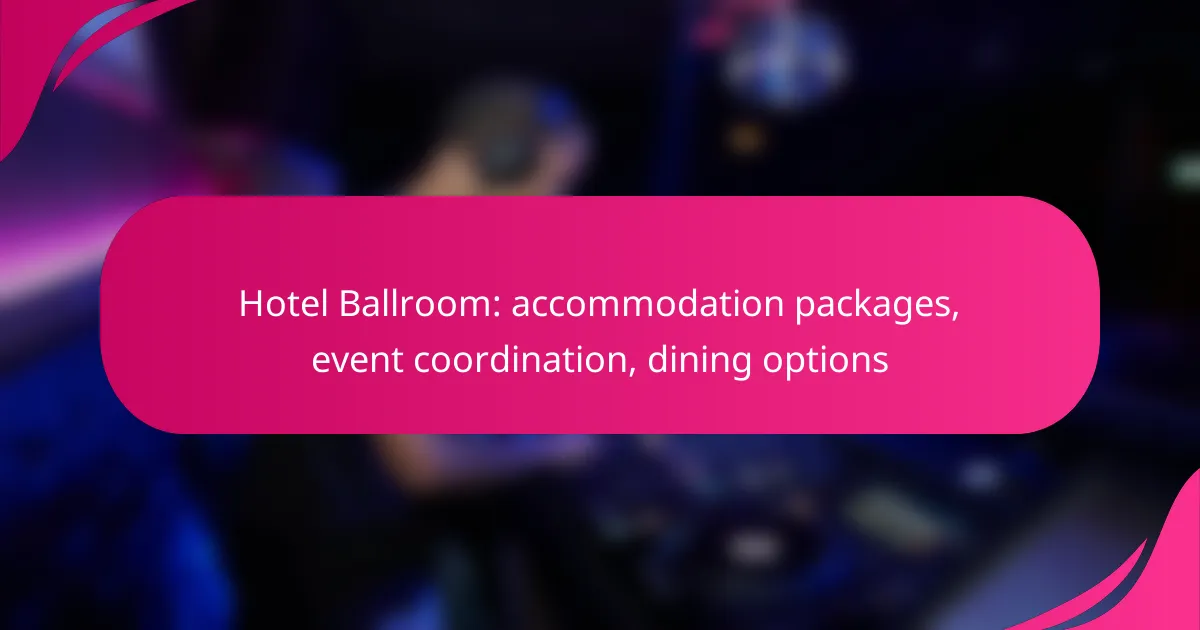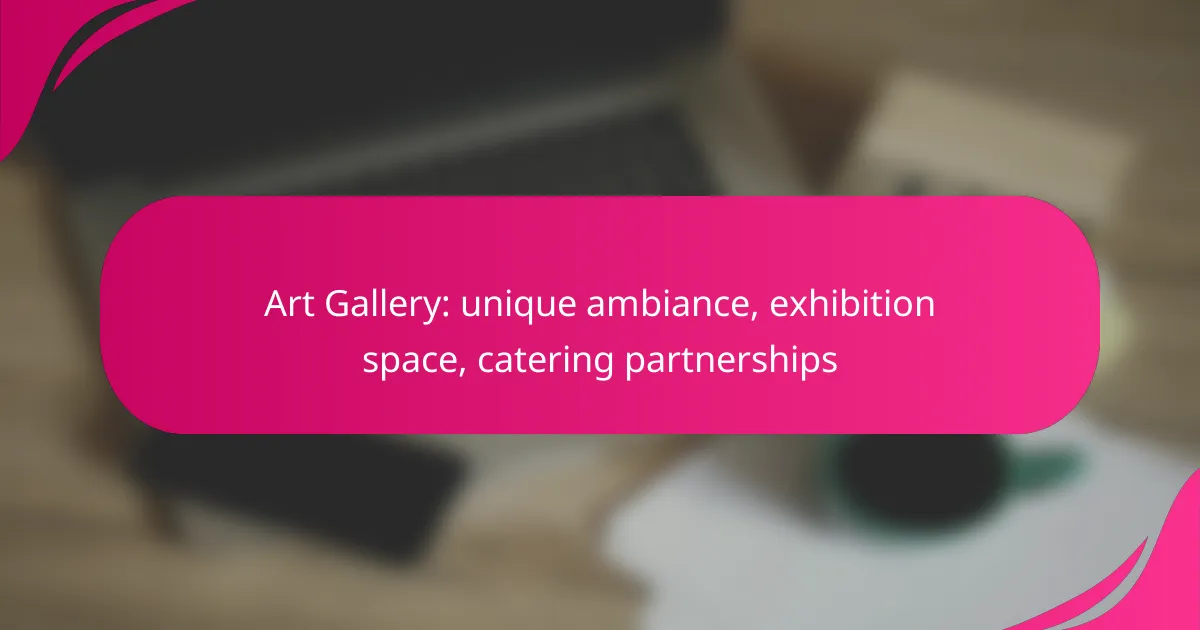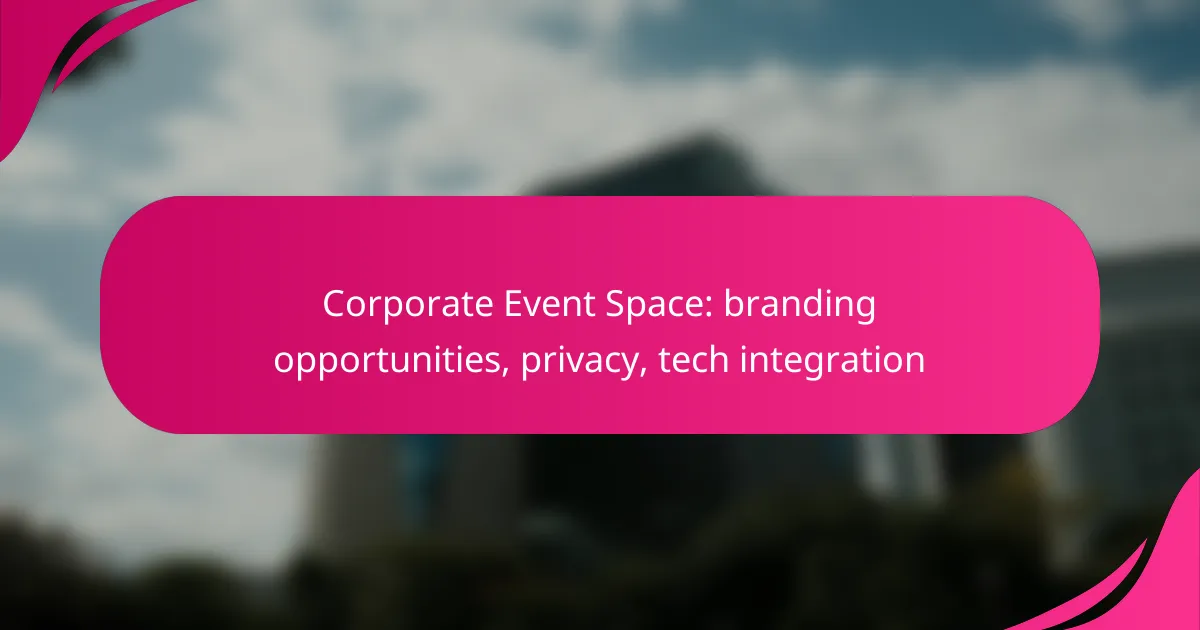Cultural centers serve as essential hubs for community involvement, offering accessible spaces that encourage local participation and creativity. With flexible areas designed for performances, workshops, and gatherings, these centers adapt to the diverse needs of the community. They explore themes of local identity, multiculturalism, and the arts, fostering engagement and learning among residents.
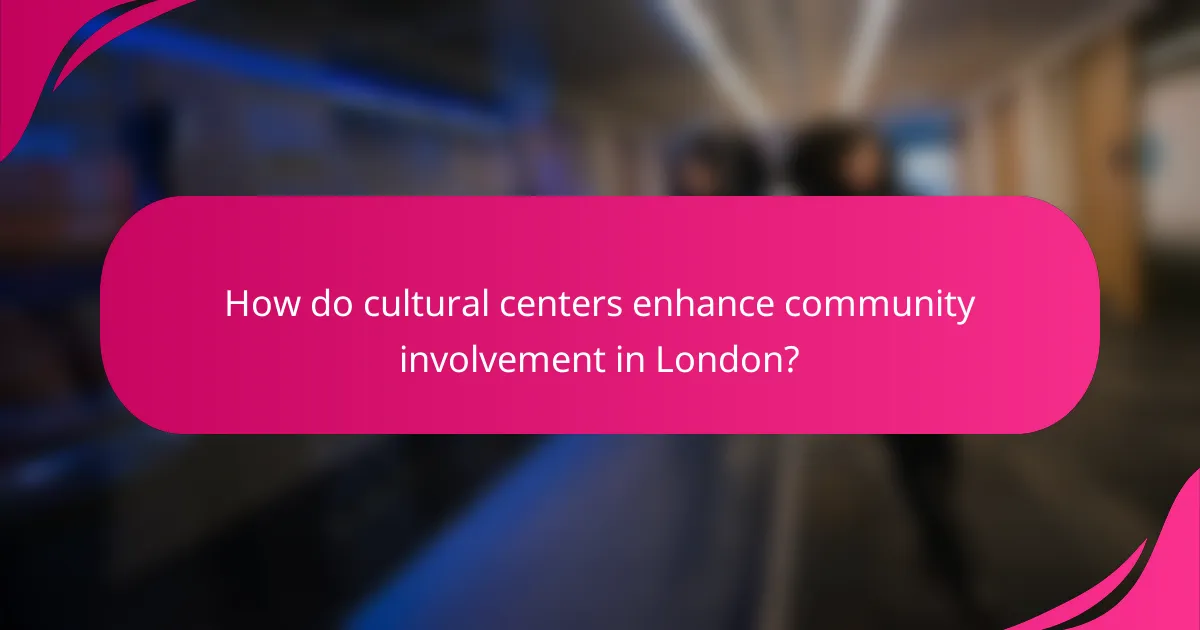
How do cultural centers enhance community involvement in London?
Cultural centers in London play a vital role in fostering community involvement by providing accessible spaces for diverse activities and encouraging local participation. They serve as hubs for creativity, learning, and collaboration, bringing residents together through various programs and initiatives.
Workshops and classes for local residents
Cultural centers offer a range of workshops and classes tailored to the interests and needs of local residents. These programs can include art, music, dance, and language courses, often designed to be affordable or even free, making them accessible to a broad audience.
Participants can benefit from hands-on experiences and expert guidance, which not only enhances their skills but also builds a sense of community. For example, a pottery class might attract individuals from different backgrounds, fostering connections and friendships.
Collaborative art projects with community members
Collaborative art projects are a powerful way for cultural centers to engage community members in creative expression. These initiatives often invite local artists and residents to work together on murals, installations, or performances that reflect the community’s identity and values.
Such projects can vary in scale and complexity, from small neighborhood murals to large-scale festivals. They encourage teamwork and dialogue, allowing participants to share their stories and perspectives, which can strengthen community bonds and promote cultural understanding.
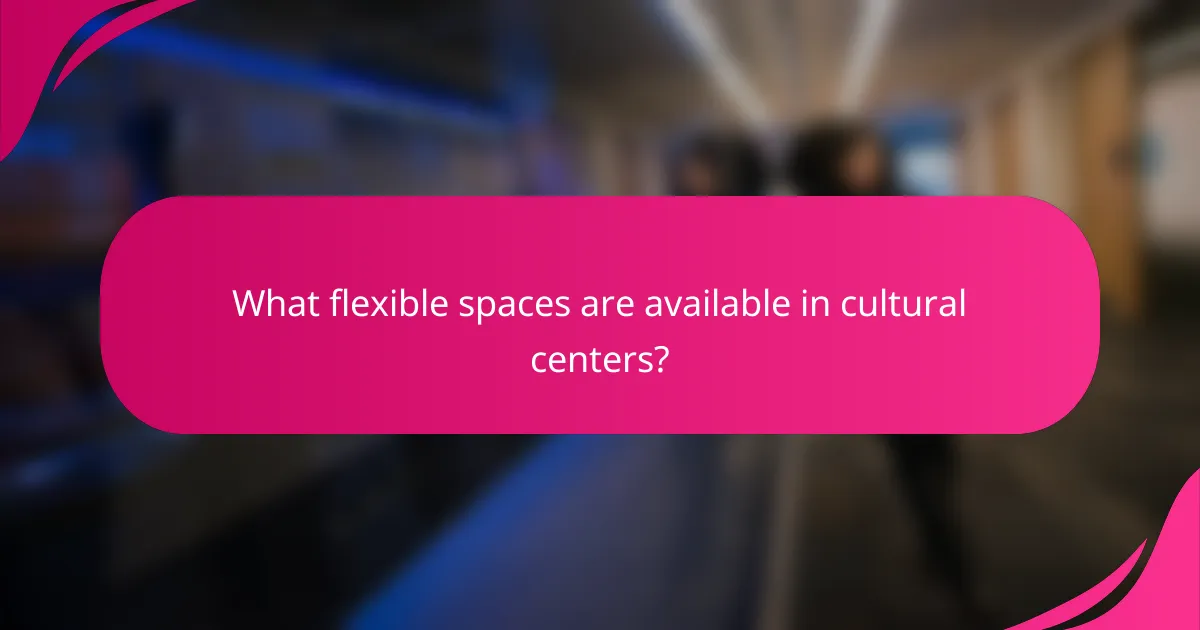
What flexible spaces are available in cultural centers?
Cultural centers typically offer a variety of flexible spaces designed to accommodate diverse activities and events. These spaces can be adapted for performances, workshops, community gatherings, and more, allowing for dynamic use by the community.
Multi-purpose event halls
Multi-purpose event halls are versatile spaces that can host a range of activities from concerts to conferences. These halls often come equipped with adjustable seating, sound systems, and lighting options, making them suitable for both large and small gatherings.
When planning an event in a multi-purpose hall, consider the layout and technology needs. For example, a theater-style setup may be ideal for presentations, while a banquet arrangement works well for social events. Check with the center for available equipment and any restrictions on usage.
Outdoor spaces for festivals and markets
Outdoor spaces in cultural centers are perfect for hosting festivals, farmers’ markets, and community fairs. These areas typically feature open layouts that can accommodate booths, stages, and seating, allowing for a vibrant atmosphere.
When organizing an outdoor event, consider the weather and seasonal factors. It’s advisable to have contingency plans for rain or extreme heat. Additionally, ensure compliance with local regulations regarding permits and safety measures, such as crowd control and sanitation facilities.

What cultural themes are explored in UK cultural centers?
UK cultural centers explore a variety of themes that reflect local identity, history, and community diversity. These themes often include local heritage, multiculturalism, and the arts, providing spaces for engagement and learning.
Local history and heritage exhibitions
Local history and heritage exhibitions in UK cultural centers showcase the unique narratives and traditions of specific regions. These exhibitions often feature artifacts, photographs, and stories that highlight the historical significance of the area.
Visitors can engage with interactive displays and guided tours that bring local history to life. Many centers collaborate with local historians and community members to ensure authenticity and relevance in their presentations.
Diversity and multicultural events
Diversity and multicultural events celebrate the rich tapestry of cultures within the UK. These events often include festivals, workshops, and performances that highlight various cultural practices, cuisines, and art forms.
Participating in these events fosters community involvement and understanding among different cultural groups. Cultural centers may host regular events, such as monthly multicultural nights or annual festivals, to encourage ongoing engagement and appreciation of diversity.
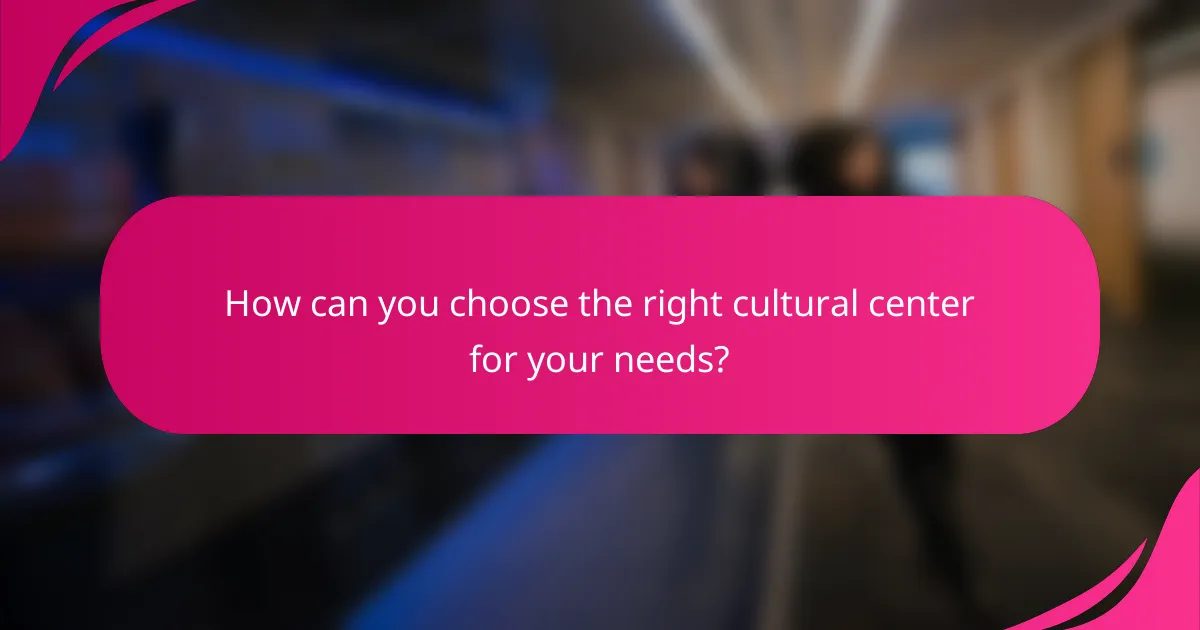
How can you choose the right cultural center for your needs?
Choosing the right cultural center involves assessing its facilities, services, and community engagement opportunities. Consider what activities you want to participate in and how the center aligns with your interests and values.
Assess available facilities and services
Start by evaluating the types of facilities offered, such as auditoriums, galleries, classrooms, and meeting spaces. Look for centers that provide flexible spaces that can accommodate various events, from workshops to performances.
Check the services available, including technical support, catering options, and accessibility features. A center with modern amenities and supportive services will enhance your experience and make events more enjoyable.
Evaluate community engagement opportunities
Investigate how the cultural center involves the community through programs, workshops, and events. A center that actively engages with local residents often fosters a sense of belonging and collaboration.
Look for opportunities to participate in volunteer work, cultural exchanges, or local art initiatives. Engaging with the community not only enriches your experience but also helps build lasting connections with others who share your interests.
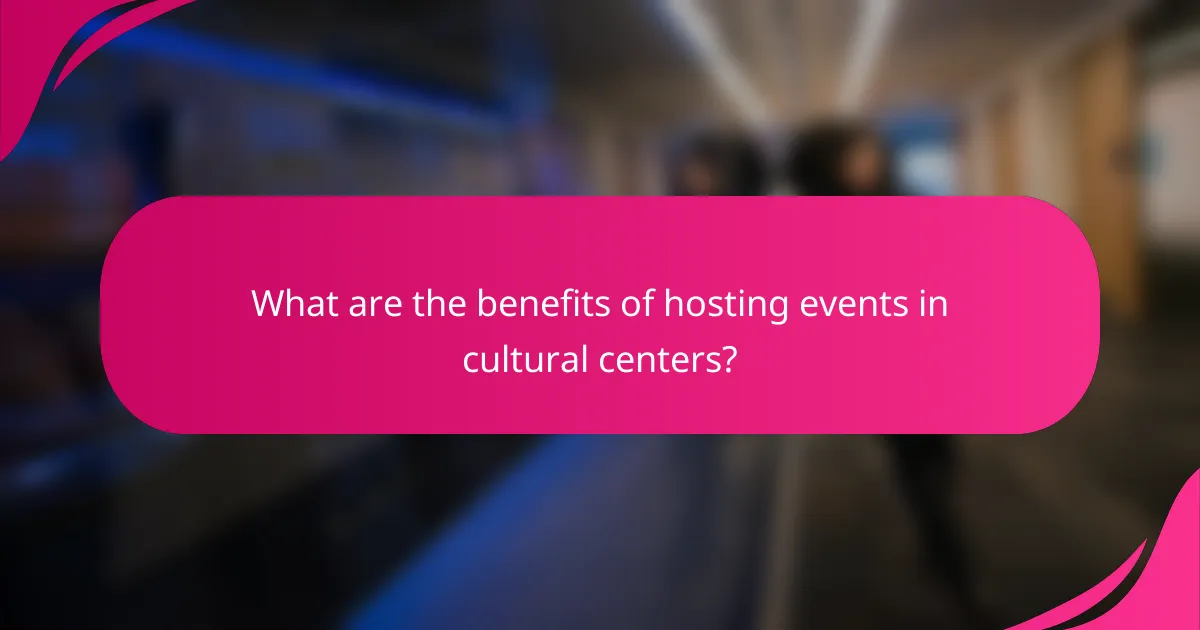
What are the benefits of hosting events in cultural centers?
Hosting events in cultural centers offers numerous advantages, including enhanced community engagement and access to versatile spaces. These venues foster cultural exchange and provide a platform for diverse activities, making them ideal for various gatherings.
Access to diverse audiences
Cultural centers attract a wide range of attendees, including local residents, tourists, and various demographic groups. This diversity enriches the event experience and encourages broader participation in cultural activities.
To maximize audience reach, consider marketing events through multiple channels such as social media, local newspapers, and community boards. Tailoring events to specific cultural themes can also draw in different groups, enhancing inclusivity.
Support for local artists and creators
Hosting events in cultural centers provides vital support for local artists and creators by offering them a platform to showcase their work. This exposure can lead to increased sales, networking opportunities, and collaborations within the community.
Consider organizing events that feature local talent, such as art exhibitions, performances, or workshops. Providing flexible spaces for these activities can help foster creativity and innovation, benefiting both the artists and the cultural center itself.
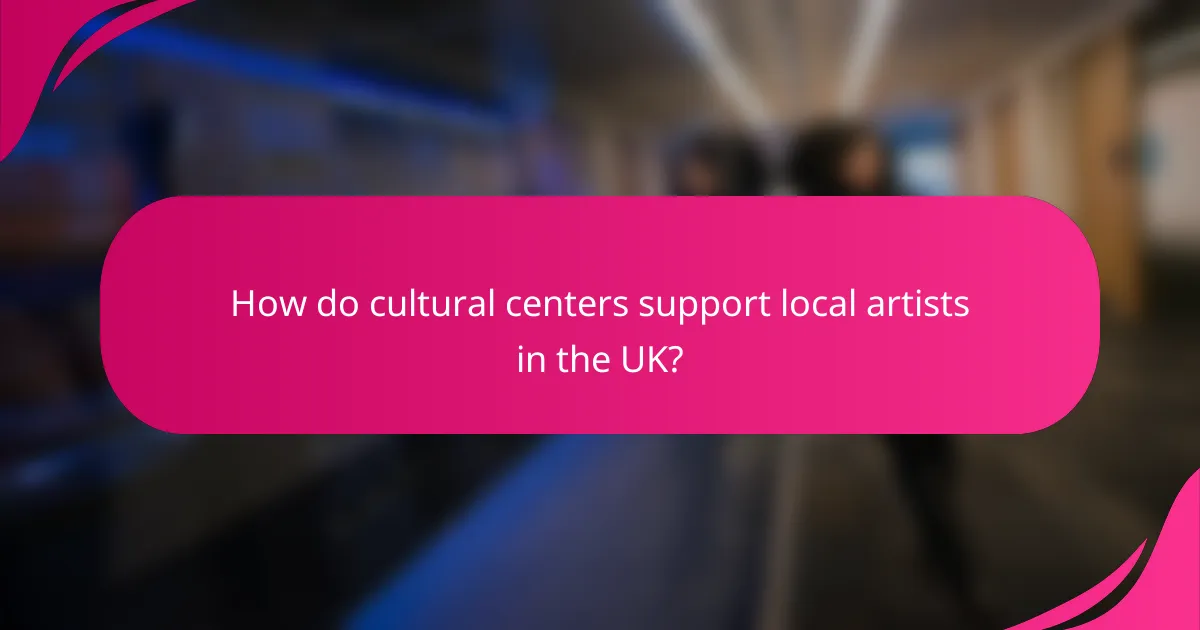
How do cultural centers support local artists in the UK?
Cultural centers in the UK play a vital role in supporting local artists by providing resources, spaces, and opportunities for exposure. They foster community engagement and collaboration, helping artists to thrive in a competitive environment.
Exhibition opportunities for emerging artists
Cultural centers often host exhibitions that showcase the work of emerging artists, allowing them to gain visibility and connect with potential buyers and patrons. These exhibitions can range from solo shows to group displays, providing a platform for diverse artistic expressions.
Many centers also offer flexible exhibition spaces that can accommodate various art forms, including visual arts, installations, and multimedia projects. This adaptability encourages artists to experiment and present their work in innovative ways.
Networking events and mentorship programs
Cultural centers frequently organize networking events that bring together artists, curators, and art enthusiasts. These gatherings create opportunities for artists to build relationships, collaborate on projects, and share resources, which can be crucial for career development.
Additionally, many centers offer mentorship programs that pair emerging artists with established professionals in the field. These programs provide guidance on artistic practices, career strategies, and navigating the art market, helping artists to refine their skills and expand their networks.

What are the challenges faced by cultural centers in urban areas?
Cultural centers in urban areas often encounter significant challenges, including limited funding and the need to balance community engagement with operational expenses. These obstacles can hinder their ability to provide diverse programs and maintain facilities that serve the public effectively.
Funding and resource limitations
Many cultural centers struggle with securing adequate funding, which can come from government grants, private donations, or ticket sales. This financial instability often leads to cuts in programming or staff, limiting the center’s ability to offer diverse cultural experiences.
To mitigate funding issues, cultural centers can explore partnerships with local businesses or community organizations. Collaborating on events or programs can provide additional resources and increase visibility, helping to attract more visitors and potential donors.
Balancing community needs with operational costs
Cultural centers must navigate the delicate balance between meeting community needs and managing operational costs. Offering free or low-cost programs can attract a larger audience but may strain resources if not properly funded.
To address this, centers can implement tiered pricing for events or membership options that allow for subsidized access while still generating revenue. Regular community surveys can also help identify the most valued programs, ensuring that resources are allocated effectively to meet those needs.

